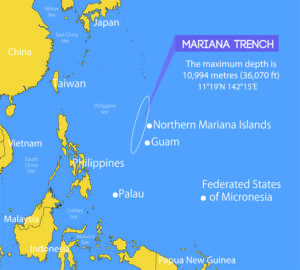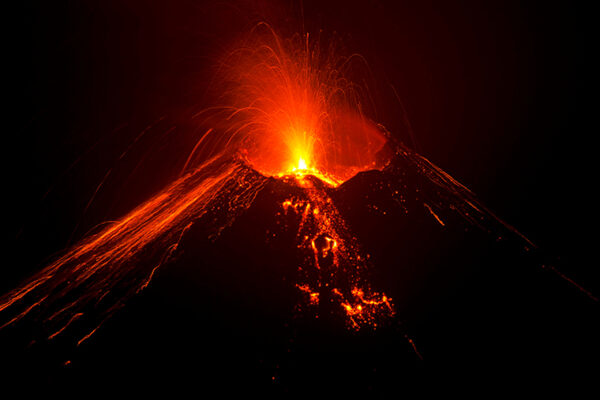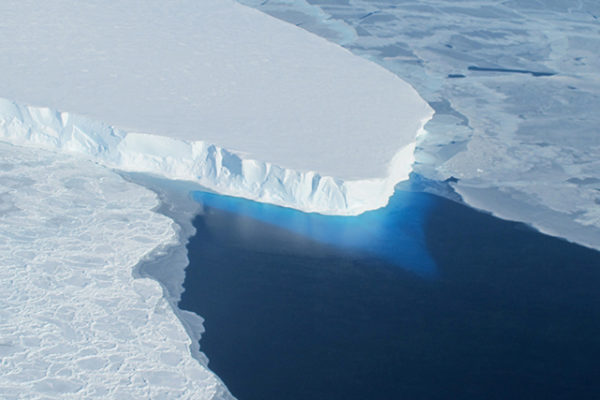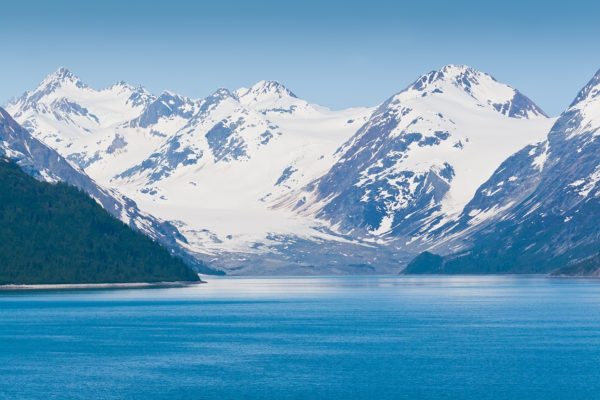Slow-motion collisions of tectonic plates under the ocean drag about three times more water down into the deep Earth than previously estimated, according to a first-of-its-kind seismic study that spans the Mariana Trench.
The observations from the deepest ocean trench in the world have important implications for the global water cycle, according to researchers in Arts & Sciences at Washington University in St. Louis.

“People knew that subduction zones could bring down water, but they didn’t know how much water,” said Chen Cai, who recently completed his doctoral studies at Washington University. Cai is the first author of the study published in the Nov. 15 issue of the journal Nature.
“This research shows that subduction zones move far more water into Earth’s deep interior — many miles below the surface — than previously thought,” said Candace Major, a program director in the National Science Foundation’s Division of Ocean Sciences, which funded the study. “The results highlight the important role of subduction zones in Earth’s water cycle.”
“Previous estimates vary widely in the amount of water that is subducted deeper than 60 miles,” said Douglas A. Wiens, the Robert S. Brookings Distinguished Professor in Earth and Planetary Sciences in Arts & Sciences and Cai’s research adviser for the study. “The main source of uncertainty in these calculations was the initial water content of the subducting uppermost mantle.”

To conduct this study, researchers listened to more than one year’s worth of Earth’s rumblings — from ambient noise to actual earthquakes — using a network of 19 passive, ocean-bottom seismographs deployed across the Mariana Trench, along with seven island-based seismographs. The trench is where the western Pacific Ocean plate slides beneath the Mariana plate and sinks deep into the Earth’s mantle as the plates slowly converge.
The new seismic observations paint a more nuanced picture of the Pacific plate bending into the trench — resolving its three-dimensional structure and tracking the relative speeds of types of rock that have different capabilities for holding water.
Bringing water down
Rock can grab and hold onto water in a variety of ways.
Ocean water atop the plate runs down into the Earth’s crust and upper mantle along the fault lines that lace the area where plates collide and bend. Then it gets trapped. Under certain temperature and pressure conditions, chemical reactions force the water into a non-liquid form as hydrous minerals — wet rocks — locking the water into the rock in the geologic plate. All the while, the plate continues to crawl ever deeper into the Earth’s mantle, bringing the water along with it.
Previous studies at subduction zones like the Mariana Trench have noted that the subducting plate could hold water. But they could not determine how much water it held and how deep it went.
“Previous conventions were based on active source studies, which can only show the top 3-4 miles into the incoming plate,” Cai said.
He was referring to a type of seismic study that uses sound waves created with the blast of an air gun from aboard an ocean research vessel to create an image of the subsurface rock structure.
“They could not be very precise about how thick it is, or how hydrated it is,” Cai said. “Our study tried to constrain that. If water can penetrate deeper into the plate, it can stay there and be brought down to deeper depths.”
An important part of Earth’s water cycle
The seismic images that Cai and Wiens obtained show that the area of hydrated rock at the Mariana Trench extends almost 20 miles beneath the seafloor — much deeper than previously thought.
The amount of water that can be held in this block of hydrated rock is considerable.
For the Mariana Trench region alone, four times more water subducts than previously calculated. These features can be extrapolated to predict the conditions under other ocean trenches worldwide.
“If other old, cold subducting slabs contain similarly thick layers of hydrous mantle, then estimates of the global water flux into the mantle at depths greater than 60 miles must be increased by a factor of about three,” Wiens said.
And for water in the Earth, what goes down must come up. Sea levels have remained relatively stable over geologic time, varying by less than 1,000 feet. This means that all of the water that is going down into the Earth at subduction zones must be coming back up somehow, and not continuously piling up inside the Earth.
Scientists believe that most of the water that goes down at the trench comes back from the Earth into the atmosphere as water vapor when volcanoes erupt hundreds of miles away. But with the revised estimates of water from the new study, the amount of water going into the earth seems to greatly exceed the amount of water coming out.
“The estimates of water coming back out through the volcanic arc are probably very uncertain,” said Wiens, who hopes that this study will encourage other researchers to reconsider their models for how water moves back out of the Earth. “This study will probably cause some re-evaluation.”
Moving beyond the Mariana Trench, Wiens along with a team of other scientists has recently deployed a similar seismic network offshore in Alaska to consider how water is moved down into the Earth there.
“Does the amount of water vary substantially from one subduction zone to another, based on the kind of faulting that you have when the plate bends?” Wiens asked. “There’s been suggestions of that in Alaska and in Central America. But nobody has looked at the deeper structure yet like we were able to do in the Mariana Trench.”



